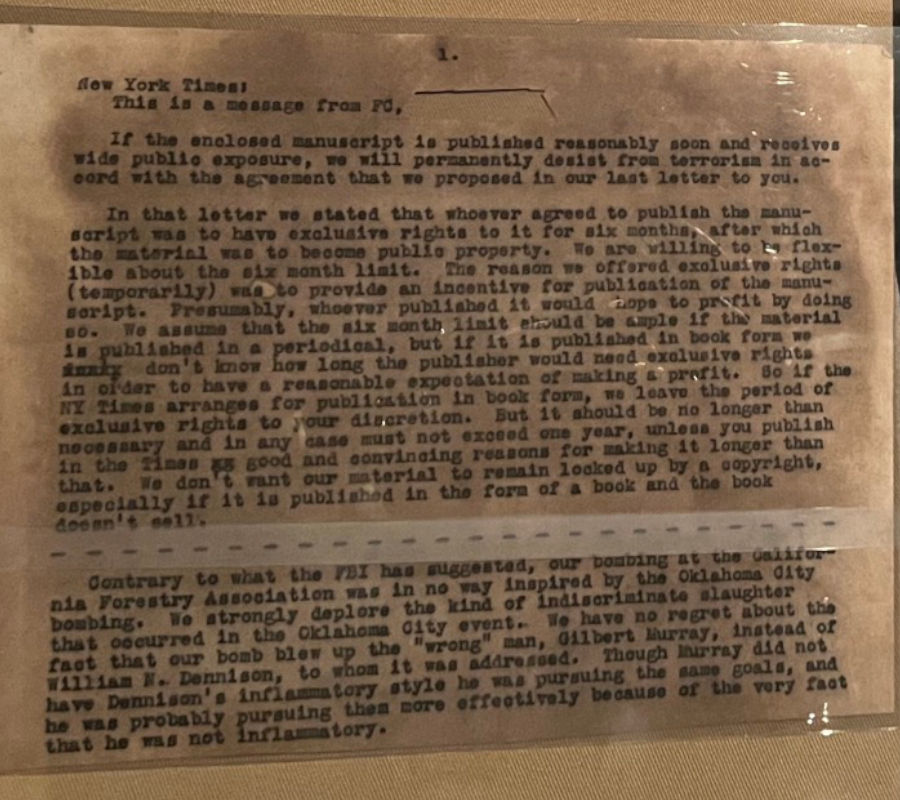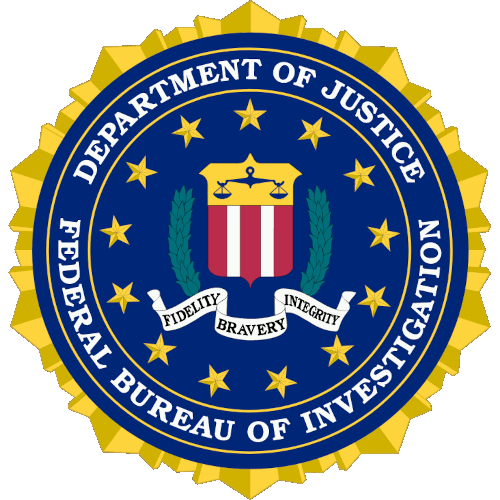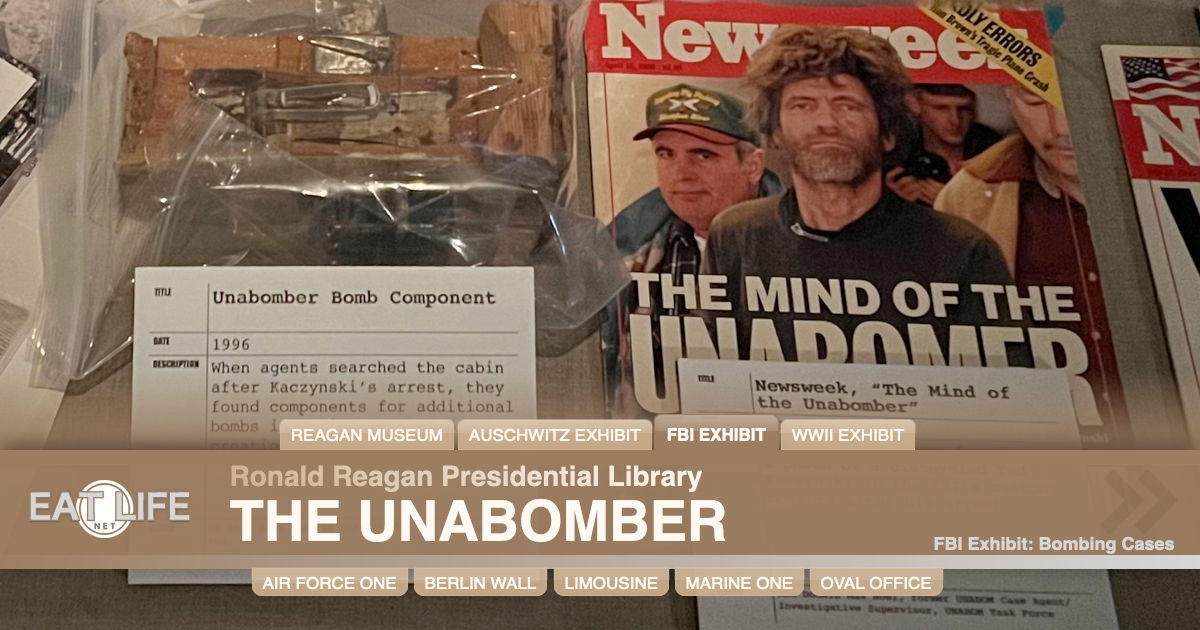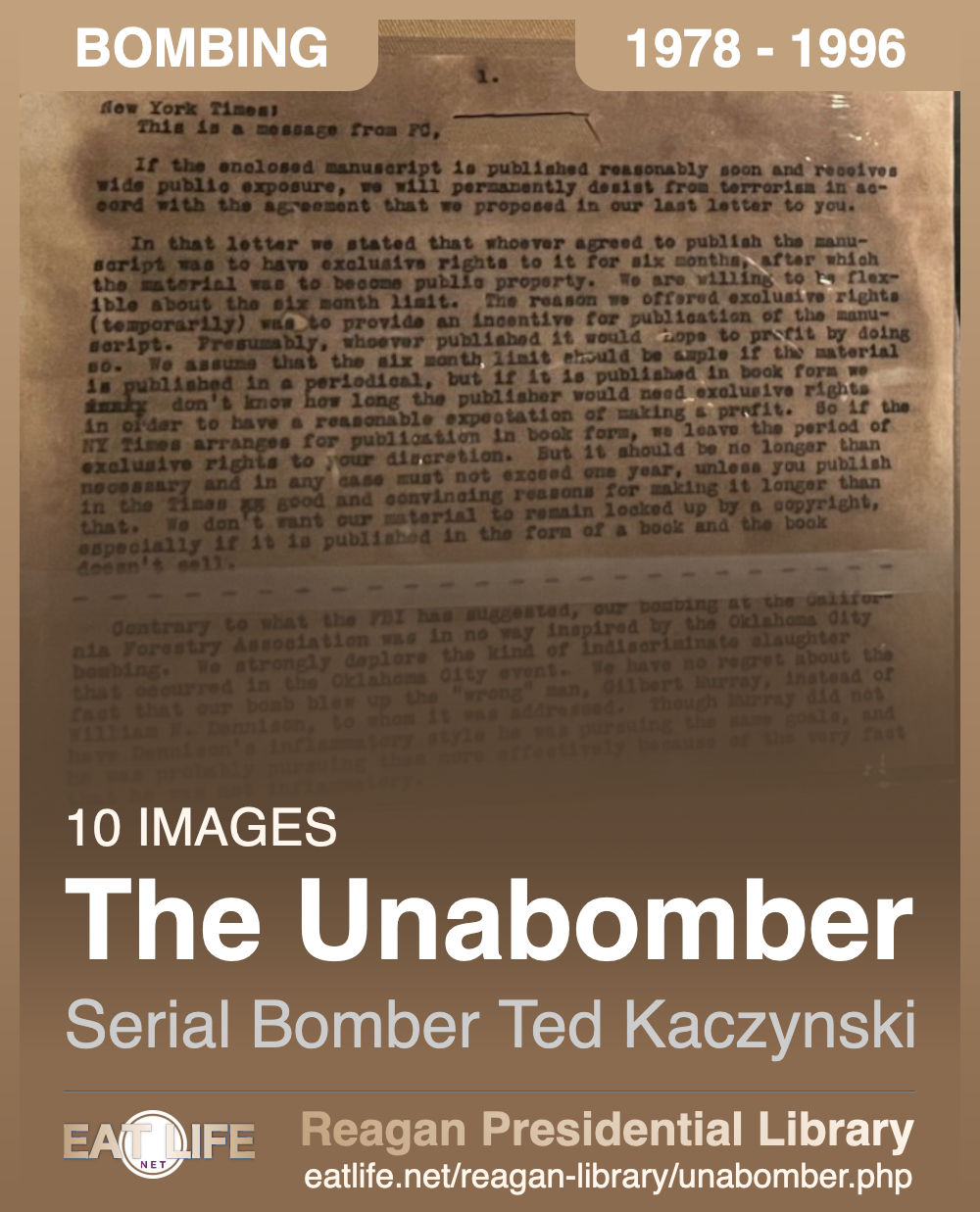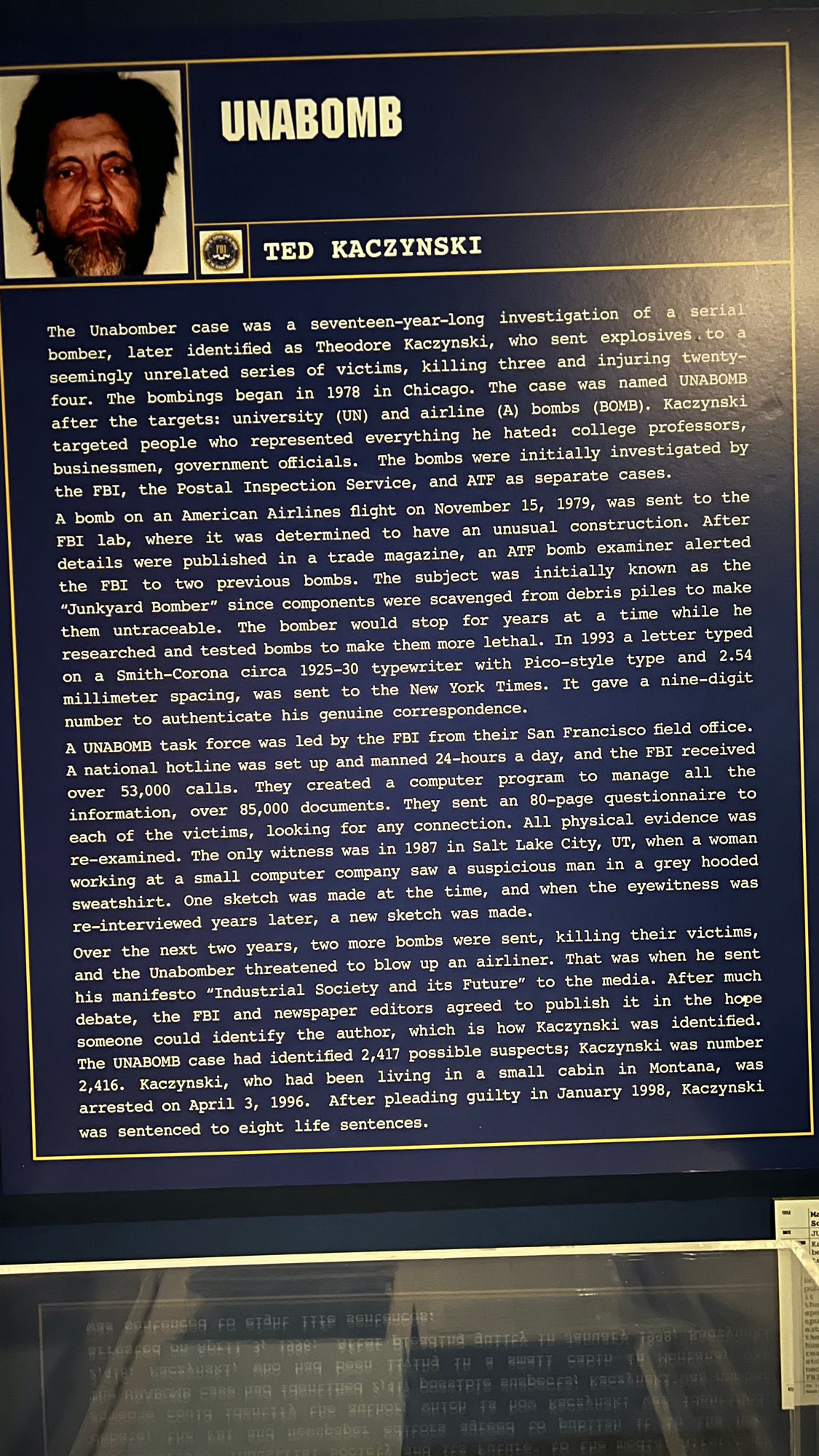
UNABOMB
The Unabomber case was a seventeen-year-long investigation a serial bomber, later identified as Theodore Kaczynski, who sent explosives to a seemingly unrelated series of victims, killing three and injuring twenty four. The bombings began in 1978 in Chicago.
The case was named UNABOMB after the targets: university (UN) and airline (A) bombs (BOMB).
Kaczynski targeted people who represented everything he hated: college professors, businessmen, government officials. The bombs were initially investigated by the FBI, the Postal Inspection Service, and ATF as separate cases.
A bomb on an American Airlines fight on November 15, 1979, was sent to the FBI lab, where it was determined to have an unusual construction. After details were published in a trade magazine, an ATF bomb examiner alerted the FBI to two previous bombs. The subject was initially known as the "Junkyard Bomber" since components were scavenged from debris piles to make them untraceable. The bomber would stop for years at a time while he researched and tested bombs to make them more lethal. In 1993 a letter typed on a Smith-Corona circa 1925-30 typewriter with Pico-style type and 2.54 millimeter spacing, was sent to the New York Times. It gave a nine-digit number to authenticate his genuine correspondence.
A UNABOMB task force was led by the FBI from their San Francisco field office. A national hotline was set up and manned 24-hours a day, and the FBI received over 53,000 calls. They created a computer program to manage all the information, over 85,000 documents. They sent an 80-page questionnaire to each of the victims, looking for any connection. All physical evidence was re-examined. The only witness was in 1987 in Salt Lake City, UT, when a woman working at a small computer company saw a suspicious man in a grey hooded sweatshirt. One sketch was made at the time, and when the eyewitness was re-interviewed years later, a new sketch was made.
Over the next two years, two more bombs were sent, killing their victims, and the Unabomber threatened to blow up an airliner. That was when he sent his manifesto "Industrial Society and its Future" to the media. After much debate, the FBI and newspaper editors agreed to publish it in the hope someone could identify the author, which is how Kaczynski was identified. The UNABOMB case had identified 2,417 possible suspects; Kaczynski was number 2,416. Kaczynski, who had been living in a small cabin in Montana, was arrested on April 3, 1996. After pleading guilty in January 1998, Kaczynski was sentenced to eight life sentences.
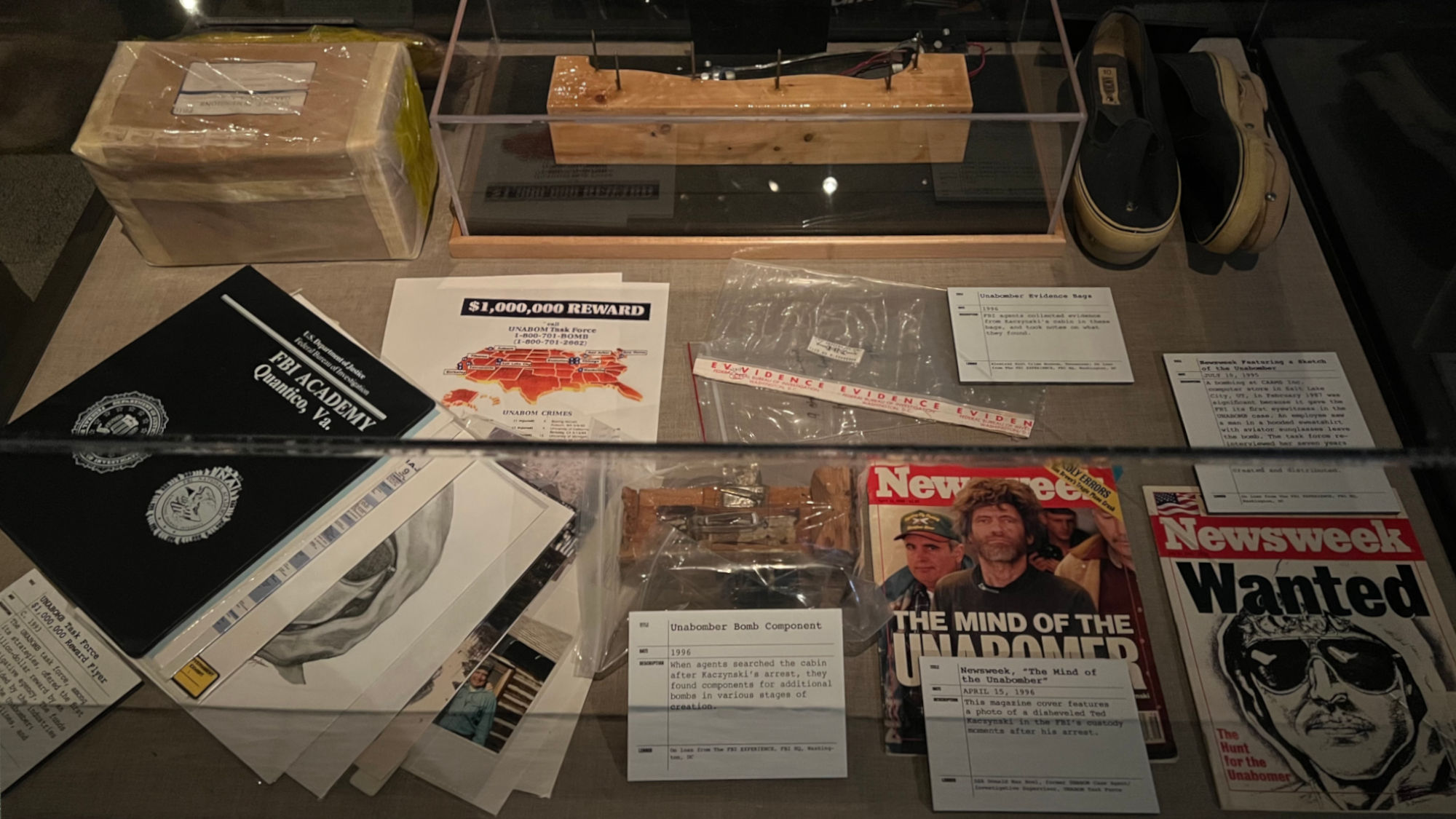
- UNABOMB Task Force $1,000,000 Reward Flyer
The UNABOMB task force, amont its strategies, offered the first million-dollar reward by an investigative agency. - Unabomber Bomb Component
When agents searched the cabin after Kaczynski's arrest, they found components for additional bombs in various stages of creation. - Newsweek, "The Mind of the Unabomber"
APRIL 15, 1996
This magazine cover features a photo of a disheveled Ted Kaczynsk1 in the FBI's custody moments after his arrest. - Unabomber Evidence Bags
FBI agents collected evidence from Kaczynski's cabin in these bags, and took notes on what found. - Newsweek Featuring a Sketch of the Unabomber
July 10, 1995
A bombing at CAAMS Inc. computer store in Salt Lake City, UT, in February 1987 was significant because it agave the FBI its first eyewitness in the UNABOMB case. An employee was a man in a hooded sweatshirt with aviator sunglasses leave the bomb. The task force re-interviewed her seven years XXXXXXXX created and distributed.
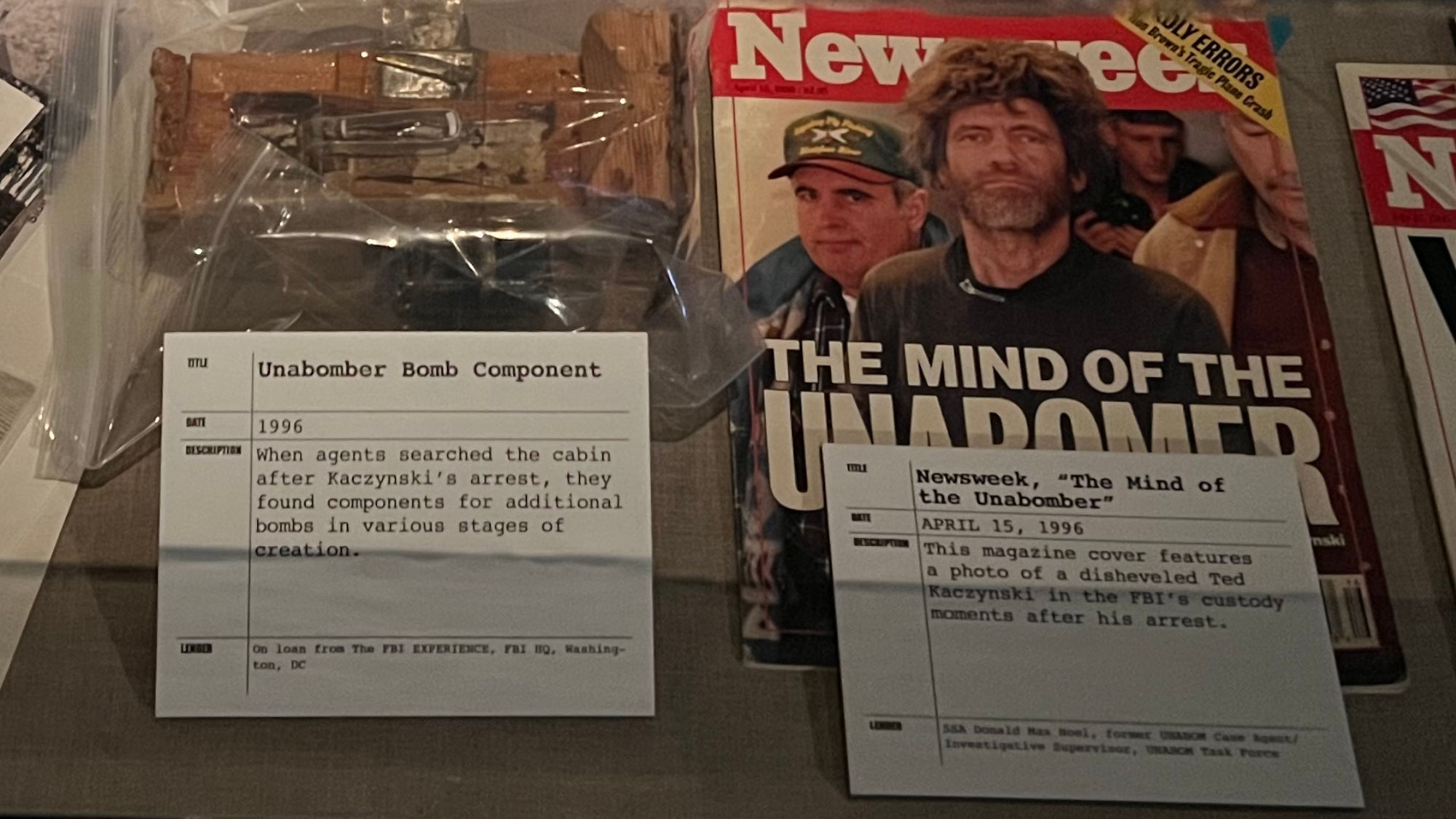
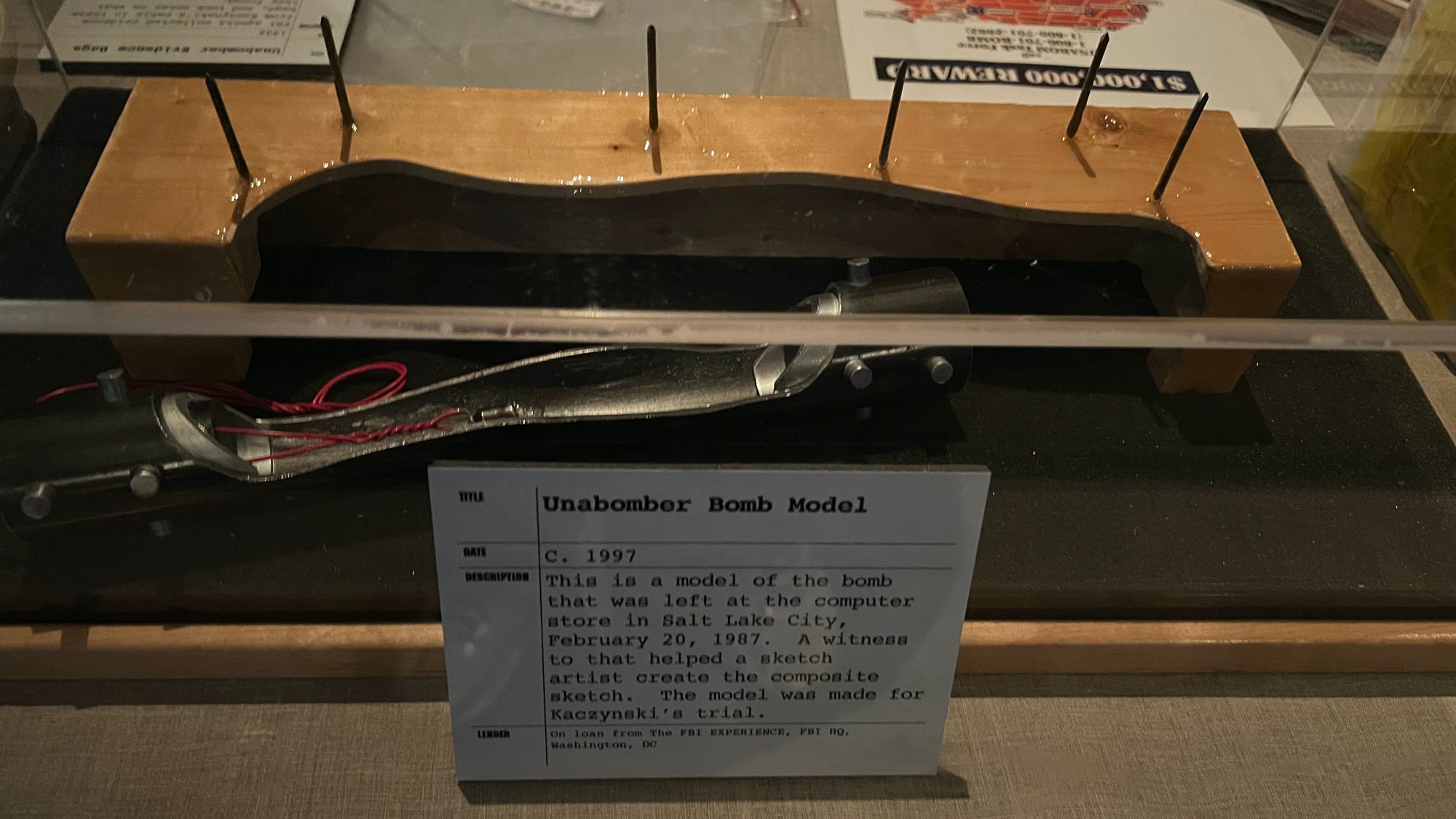
This is a model of the bomb that was left at the computer atore in Salt Lake City, February 20, 1987. A witness to that helped a sketch artist create the composite sketch. The model was made for Kaczynski's trial.
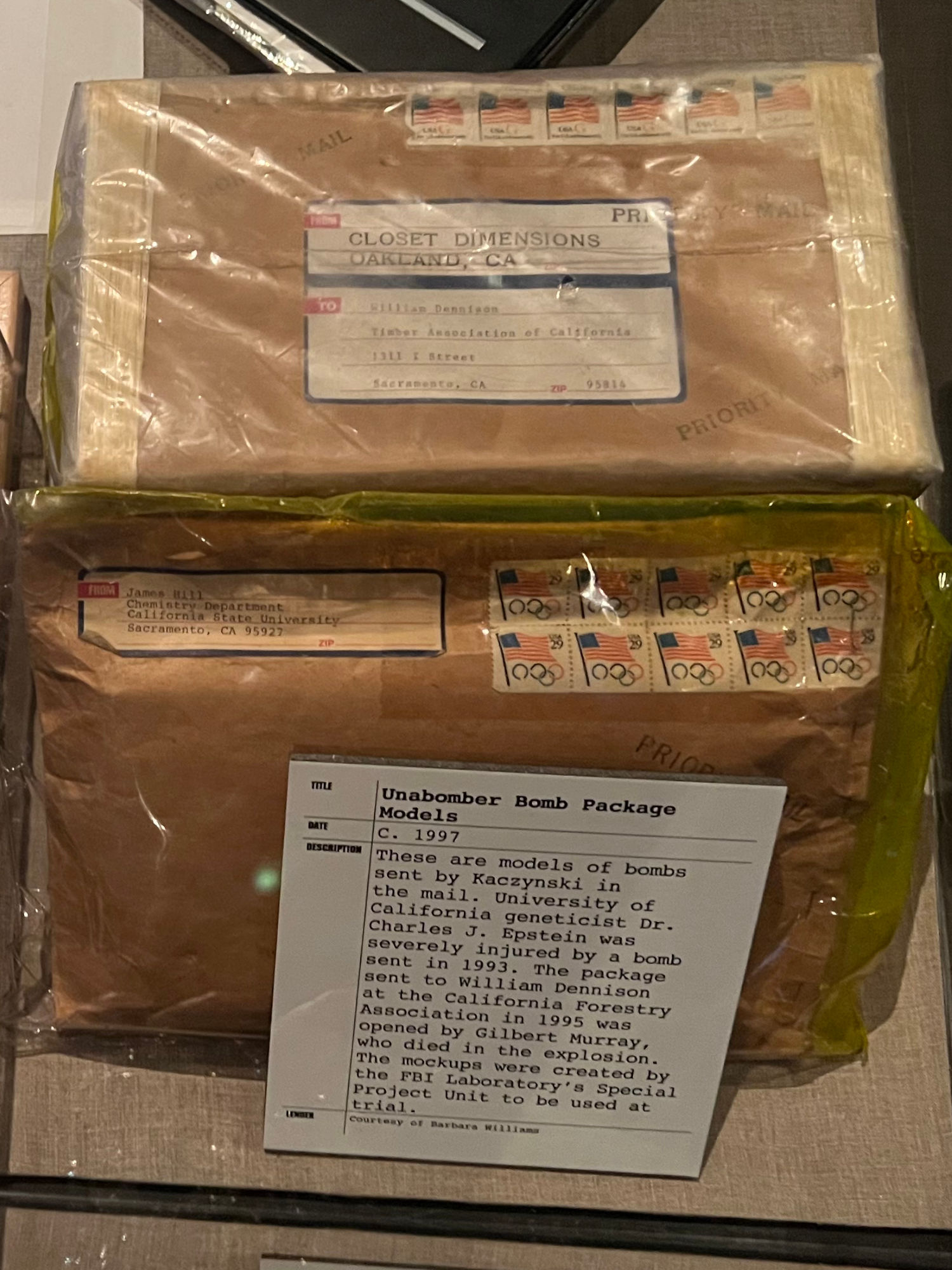
These are models of bombs sent by Kaczynaki in the mail. University of California geneticist Dr. Charles J. Epstein was severely injured by a bomb sent in 1993. The package sent to William Dennison at the California Forestry Association in 1995 was opened by Gilbert Murray, who died in the explosion.
The mockups were created by the FBI Laboratory's Special Project Unit to be used at trial.
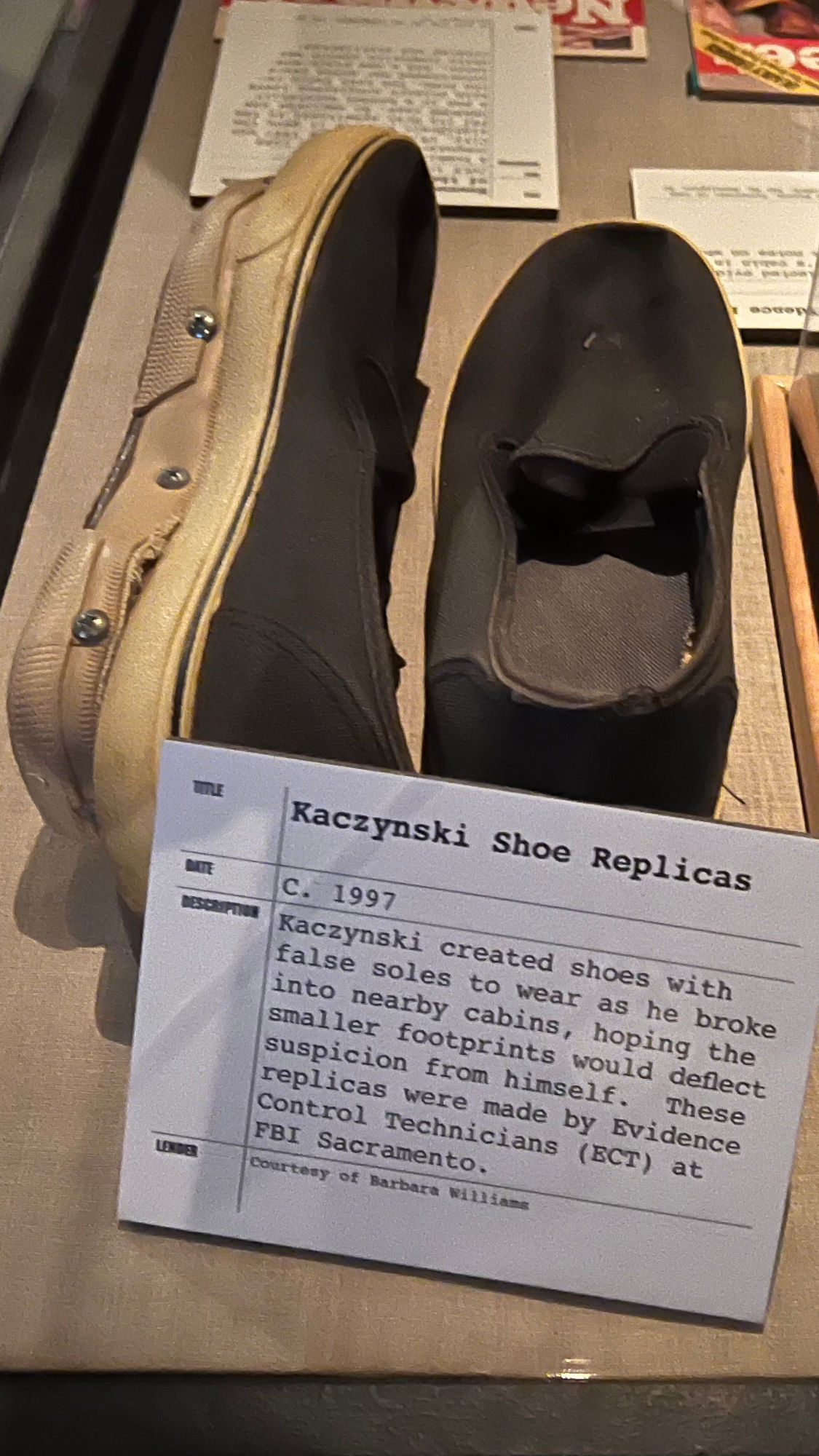
Kaczynski created shoes with false soles to wear as he broke into nearby cabins, hoping the smaller footprints would deflect suspicion from himself.
These replicas were made by Evidence Control Technicians (ECT) at FBI Sacramento.
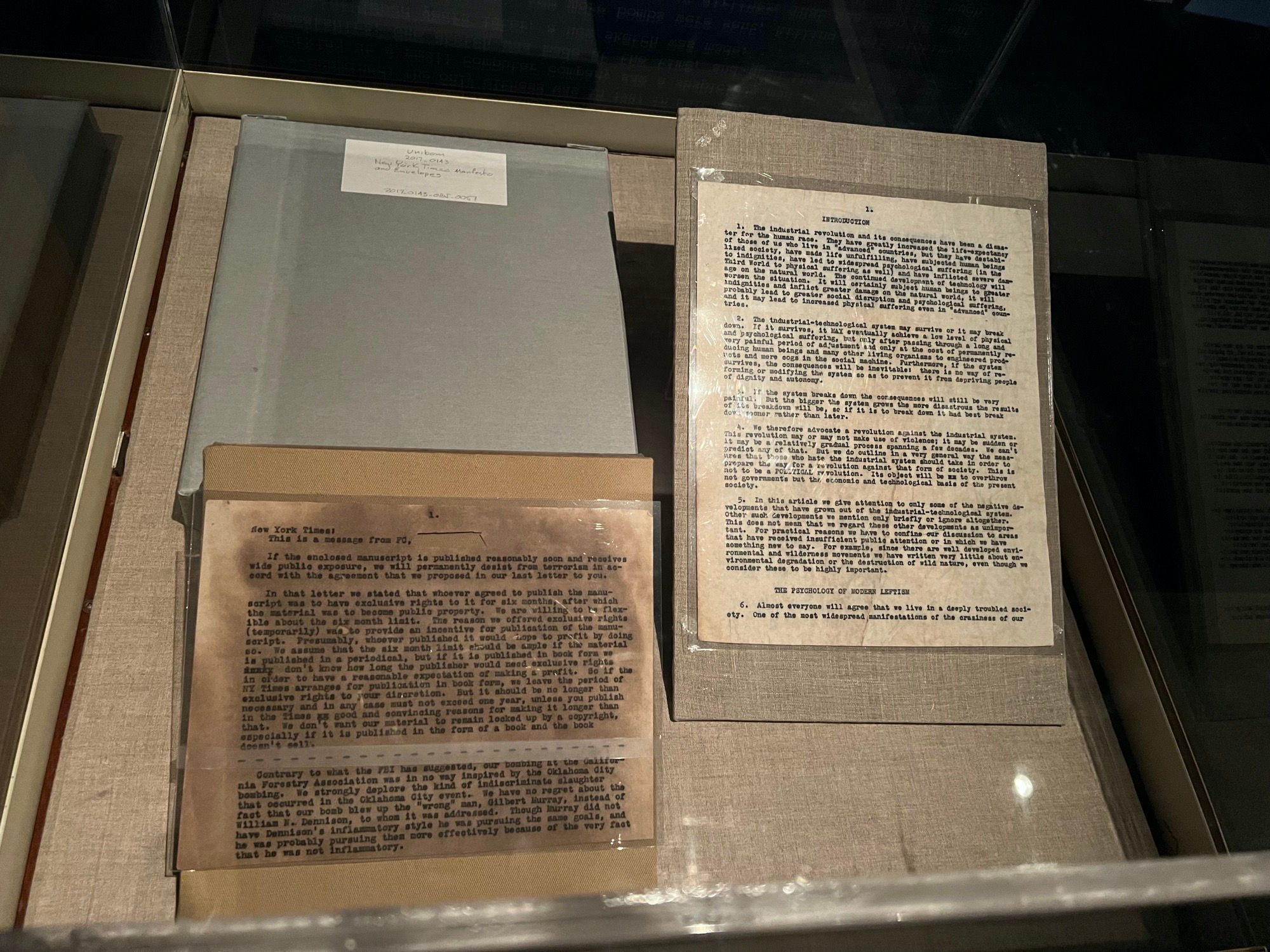
"Industrial Society and its Future"
UNABOMBERThe Unabomber's Brother David
Kaczynski targeted his victims because of their role in technological development. He composed this manifesto on the subject and offered to halt bombings in exchange for its publication. After much debate it was agreed that publishing the work, with its unusual spellings and acronyms, might spur someone to identify the author. Linda Kaczynski read the manifesto and made her husband David, Ted's brother, read it as well, and "the hair stood up on the back of his neck." David then contacted the FBI.
New York Times
This is a message from FC,
If the enclosed manuscript is published reasonably soon and receives wide public exposure, we will permanently desist from terrorism in accord with the agreement that we proposed in our last letter to you.
In that letter we stated that whoever agreed to publish the manuscript was to have exclusive rights to it for six months, after which the material was to become public property. We are willing to be flexible about the six month limit. The reason we offered exclusive rights (temporarily) was to provide an incentive for publication of the manuscript. Presumably, whoever published it would hope to profit by doing so. We assume that the six month limit should be ample if the material is published in a periodical, but if it is published in book form we don't know how long the publisher would need exclusive rights in order to have a reasonable expectation of making a profit. So if the NY Times arranges for publication in book form, we leave the period of exclusive rights to your discretion. But it should be no longer than necessary and in any case must not exceed one year, unless you publish in the Times XX good and convincing reasons for making it longer than that. We don't want our material to remain locked up by a copyright, especially if it is published in the form of a book and the book doesn't sell.
Contrary to what the FBI has suggested, our bombing at the California Forestry Association was in no way inspired by the Oklahoma City bombing. We strongly deplore the kind of indiscriminate slaughter that occurred in the Oklahoma City event. We have no regret about the fact that our bomb blew up the "wrong" man, Gilbert Murray, instead of William N. Dennison, to whom it was addressed. Though Murray did not have Dennison's inflammatory style he was pursuing the same goals, and he was probably pursuing them more effectively because of the very fact that he was not inflammatory.
1.
INTRODUCTION
- The Industrial Revolution and its consequences have been a disaster for the human race. They have greatly increased the life-expectancy of those of us who live in "advanced" countries, but they have destabilized society, have made life unfulfilling, have subjected human beings to indignities, have led to widespread psychological suffering (in the Third World to physical suffering as well) and have inflicted severe damage on the natural world. The continued development of technology will worsen the situation. It will certainly subject human beings to greater indignities and inflict greater damage on the natural world, it will probably lead to greater social disruption and psychological suffering, and it may lead to increased physical suffering even in "advanced" countries.
- The industrial-technological system may survive or it may break down. If it survives, it MAY eventually achieve a low level of physical and psychological suffering, but only after passing through a long and very painful period of adjustment and only at the cost of permanently reducing human beings and many other living organisms to engineered products and mere cogs in the social machine. Furthermore, if the system survives, the consequences will be inevitable: There is no way of reforming or modifying the system so as to prevent it from depriving people of dignity and autonomy.
- If the system breaks down the consequences will still be very painful. But the bigger the system grows the more disastrous the results of its breakdown will be, so if it is to break down it had best break down sooner rather than later.
- We therefore advocate a revolution against the industrial system. This revolution may or may not make use of violence: it may be sudden or it may be a relatively gradual process spanning a few decades. We can't predict any of that. But we do outline in a very general way the measures that those who hate the industrial system should take in order to prepare the way for a revolution against that form of society. This is not to be a POLITICAL revolution. Its object will be to overthrow not governments but the economic and technological basis of the present society.
- In this article we give attention to only some of the negative developments that have grown out of the industrial-technological system. Other such developments we mention only briefly or ignore altogether. This does not mean that we regard these other developments as unimportant. For practical reasons we have to confine our discussion to areas that have received insufficient public attention or in which we have something new to say. For example, since there are well-developed environmental and wilderness movements, we have written very little about environmental degradation or the destruction of wild nature, even though we consider these to be highly important.
THE PSYCHOLOGY OF MODERN LEFTISM
- Almost everyone will agree that we live in a deeply troubled society. One of the most widespread manifestations of the craziness of our
April 3, 2016, is the 20th anniversary of the arrest of Theodore "Ted" Kaczynski, known more widely as the Unabomber. Kaczynski's first bomb exploded at a Chicago university in 1978. For the next 17 years, he mailed or delivered bombs that killed three people and injured 24 more.In fact, the name Unabomber was inspired by the case name UNABOM, which is derived from the UNiversity and Airline BOMbing targets. He threatened to blow up airliners, and he worked meticulously to leave no forensic evidence. All Kaczynski's bombs were made from untraceable scrap material that he could obtain anywhere.
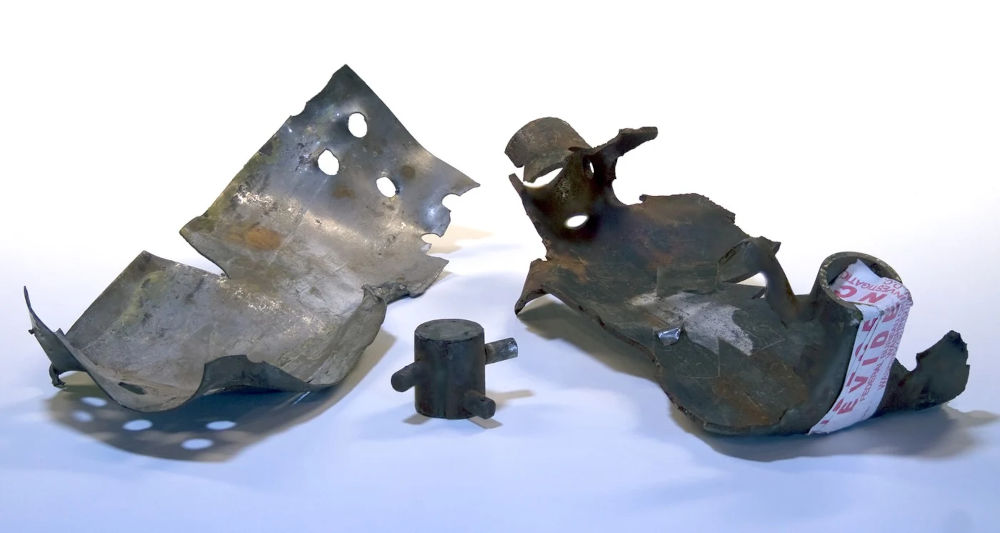 Pieces of one of the bombs stem from the February 1987 bombing at CAAMS Inc., a computer store in Salt Lake City, Utah.
Pieces of one of the bombs stem from the February 1987 bombing at CAAMS Inc., a computer store in Salt Lake City, Utah.The CAAMS Inc. bombing is significant because it gave the FBI its first eyewitness when someone in the vicinity saw a man in a hooded sweatshirt with aviator sunglasses leave the bomb in a bag on the road. In the photo, the middle piece of the bomb shrapnel also bears Kaczynski's signature inscription-the letters "FC" are etched into one side.
In 1995, the Unabomber sent the FBI a 35,000-word manifesto, which Director Louis Freeh and Attorney General Janet Reno approved to be published. The Washington Post, The New York Times, and Penthouse magazine all published the manifesto. Linda Patrik, wife of Ted's brother David Kaczynski, recognized the ideas in the writings and convinced her husband to turn in his brother, along with letters and documents he had written, to the FBI. Ted Kaczynski was arrested in 1996 and pleaded guilty in 1998. He is serving a life sentence in a prison in Colorado.
FBIThe Unabomber
How do you catch a twisted genius who aspires to be the perfect, anonymous killer-who builds untraceable bombs and delivers them to random targets, who leaves false clues to throw off authorities, who lives like a recluse in the mountains of Montana and tells no one of his secret crimes?That was the challenge facing the FBI and its investigative partners, who spent nearly two decades hunting down this ultimate lone wolf bomber.
The man that the world would eventually know as Theodore Kaczynski came to our attention in 1978 with the explosion of his first, primitive homemade bomb at a Chicago university. Over the next 17 years, he mailed or hand delivered a series of increasingly sophisticated bombs that killed three Americans and injured nearly two dozen more. Along the way, he sowed fear and panic, even threatening to blow up airliners in flight.
In 1979, an FBI-led task force that included the ATF and U.S. Postal Inspection Service was formed to investigate the "UNABOM" case, code-named for the UNiversity and Airline BOMbing targets involved. The task force would grow to more than 150 full-time investigators, analysts, and others. In search of clues, the team made every possible forensic examination of recovered bomb components and studied the lives of victims in minute detail. These efforts proved of little use in identifying the bomber, who took pains to leave no forensic evidence, building his bombs essentially from "scrap" materials available almost anywhere. And the victims, investigators later learned, were chosen randomly from library research.
We felt confident that the Unabomber had been raised in Chicago and later lived in the Salt Lake City and San Francisco areas. This turned out to be true. His occupation proved more elusive, with theories ranging from aircraft mechanic to scientist. Even the gender was not certain: although investigators believed the bomber was most likely male, they also investigated several female suspects.
The big break in the case came in 1995. The Unabomber sent us a 35,000 word essay claiming to explain his motives and views of the ills of modern society. After much debate about the wisdom of "giving in to terrorists," FBI Director Louis Freeh and Attorney General Janet Reno approved the task force's recommendation to publish the essay in hopes that a reader could identify the author.
After the manifesto appeared in The Washington Post, thousands of people suggested possible suspects. One stood out: David Kaczynski described his troubled brother Ted, who had grown up in Chicago, taught at the University of California at Berkeley (where two of the bombs had been placed), then lived for a time in Salt Lake City before settling permanently into the primitive 10' x 14' cabin that the brothers had constructed near Lincoln, Montana.
Most importantly, David provided letters and documents written by his brother. Our linguistic analysis determined that the author of those papers and the manifesto were almost certainly the same. When combined with facts gleaned from the bombings and Kaczynski's life, that analysis provided the basis for a search warrant.
On April 3, 1996, investigators arrested Kaczynski and combed his cabin. There, they found a wealth of bomb components; 40,000 handwritten journal pages that included bomb-making experiments and descriptions of Unabomber crimes; and one live bomb, ready for mailing.
Kaczynski's reign of terror was over. His new home, following his guilty plea in January 1998: an isolated cell in a "Supermax" prison in Colorado.
TIMELINE: UNABOMBER DEVICES May 25, 1978: A passerby found a package, addressed and stamped, in a parking lot at the University of Illinois, Chicago Circle Campus. The package was returned to the person listed on the return address, Northwestern University Professor Buckley Crist, Jr. He did not recognize the package and called campus security. The package exploded upon opening and injured the security officer. May 9, 1979: A graduate student at Northwestern University is injured when he opened a box that looked like a present. It had been left in a room used by graduate students. November 15, 1979: American Airlines Flight 444 flying from Chicago to Washington, D.C., fills with smoke after a bomb detonates in the luggage compartment. The plane lands safely, since the bomb did not work as intended. Several passengers suffer from smoke inhalation. June 10, 1980: United Airlines President Percy Woods is injured when he opened a package holding a bomb encased in a book called Ice Brothers by Sloan Wilson. October 8, 1981: A bomb wrapped in brown paper and tied with string is discovered in the hallway of a building at the University of Utah in Salt Lake City. The bomb is safely detonated without causing injury. May 5, 1982: A bomb sent to the head of the computer science department at Vanderbilt University injures his secretary, after she opened it in his office. July 2, 1982: A package bomb left in the break room of Cory Hall at the University of California, Berkeley explodes and injures an engineering professor. May 15, 1985: Another bomb in Cory Hall at the University of California, Berkeley injures an engineering student. June 13, 1985: A suspicious package sent to Boeing Fabrication Division in Washington is safely detonated, but most of the forensic evidence was lost. November 15, 1985: A University of Michigan psychology professor and his assistant are injured when they opened a package containing a three-ring binder that had a bomb. The bomber included a letter asking the professor to review a student's master thesis. December 11, 1985: A bomb left in the parking lot of a Sacramento computer store kills the store's owner. February 20, 1987: Another bomb left in the parking lot of a Salt Lake City computer store severely injures the son of the store's owner. A store employee sees the man leave the bomb, and that witness account helped a sketch artist create the composite sketch. June 22, 1993: A geneticist at the University of California is injured after opening a package that exploded in his kitchen. June 24, 1993: A prominent computer scientist from Yale University lost several fingers to a mailed bomb. December 19, 1994: An advertising executive is killed by a package bomb sent to his New Jersey home. April 24, 1995: A mailed bomb kills the president of the California Forestry Association in his Sacramento office. THE UNABOMBER
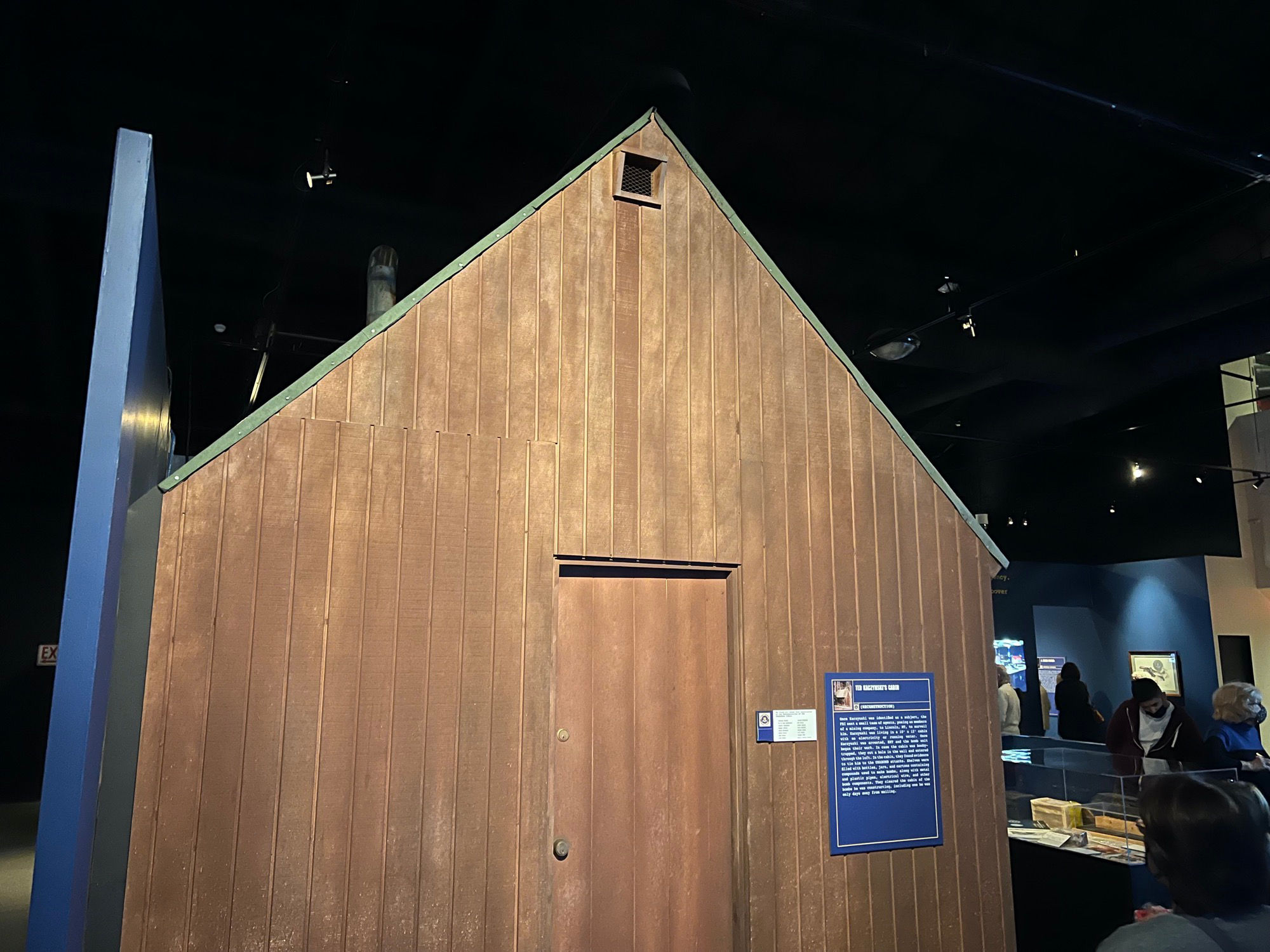
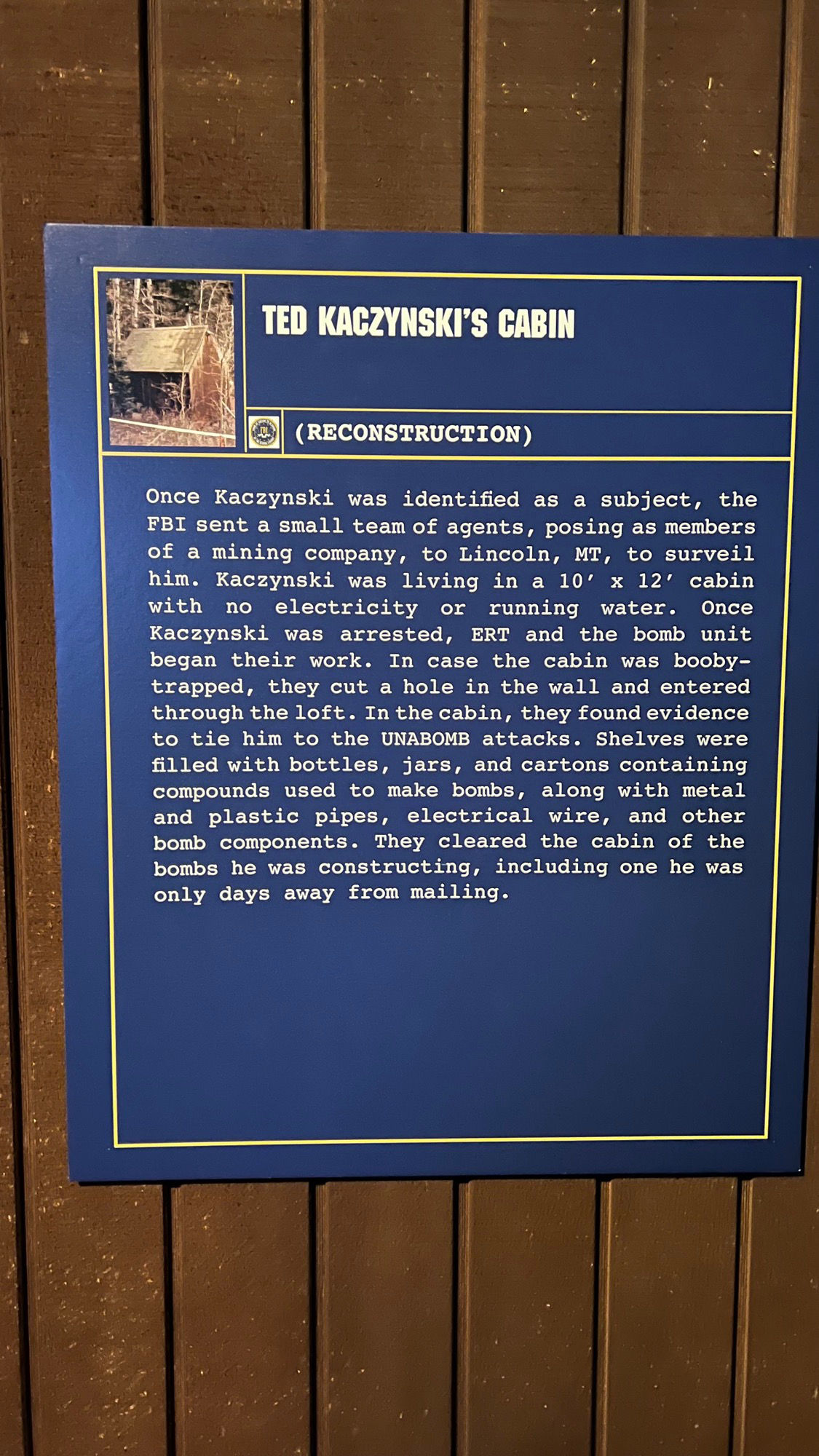
(Reconstruction)
Once Kaczynski was identified as a subject, the FBI sent a small team of agents, posing as members of a mining company, to Lincoln, MT, to surveil him. Kaczynski was living in a 10' × 12' cabin with no electricity or running water. Once Kaczynski was arrested, ERT and the bomb unit began their work. In case the cabin was booby-trapped, they cut a hole in the wall and entered through the loft. In the cabin, they found evidence to tie him to the UNABOMB attacks. Shelves were filled with bottles, jars, and cartons containing compounds used to make bombs, along with metal and plastic pipes, electrical wire, and other bomb components. They cleared the cabin of the bombs he was constructing, including one he was only days away from mailing.
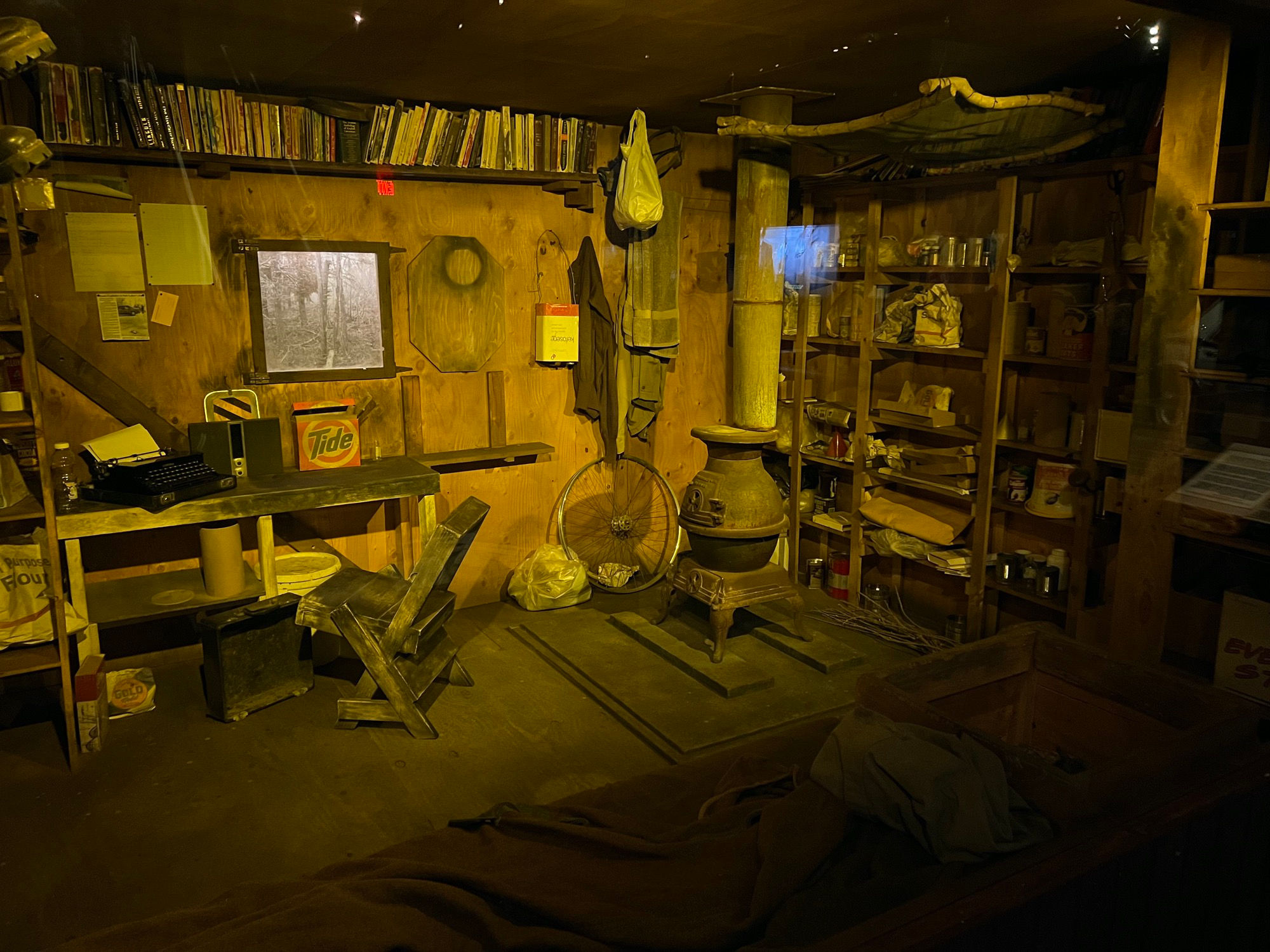
On April 3, 1996, FBI agents arrested Theodore "Ted" Kaczynski, also known as the Unabomber, at his cabin in Montana. For 17 years, Kaczynski had delivered and mailed bombs to his targets throughout the country.Terry Turchie served as the assistant special agent in charge of the task force that investigated the case. He described the cabin as a dark and gloomy place. It had one dirty window that only let in a few rays of sunlight.
It contained a trove of evidence that helped prosecutors build a case against him.
As agents searched the cabin, they discovered shelves filled with bottles and jars.
Most of the cartons contained compounds used to make bombs. The shelves also housed pieces of metal and plastic pipes, electrical wire, and other bomb components.
FBI agents stopped searching the cabin after about 24 hours because they discovered a bomb wrapped under a bed in the cabin.
Kaczynski received a life sentence for his crimes.
Ted Kaczynski
Ted Kaczynski was a mathematician who became notorious for a campaign of letter bombs he sent as the "Unabomber" over a nearly 20-year period, resulting in three fatalities.Biography.com Who Was Ted Kaczynski?
Ted Kaczynski was a serial bomber who killed three people and injured 23 more between 1978 and 1995, earning him the notorious "Unabomber" nickname. A mathematics prodigy who attended Harvard University, Kaczynski taught at the University of California at Berkeley before retreating to a survivalist lifestyle in the Montana woods. Kaczynski mailed a series of bombs to universities and airlines and, in 1995, wrote a 35,000-word manifesto on what he believed were problems of modern society. FBI agents arrested Kaczynski in 1996, and two years later, he was sentenced to life in prison. Kaczynski died by apparent suicide at the Federal Medical Center in Butner, North Carolina, in June 2023.Early Life
Theodore John Kaczynski was born on May 22, 1942, in Chicago, the oldest child of a Polish-American couple, Wanda and Theodore. As a baby, Kaczynski had an allergic reaction to some medication and spent time in isolation while recovering. Some reports indicate that he had a noticeable change in personality after being hospitalized. The arrival of his younger brother, David, also allegedly had a strong effect on him.When he was a child, the family moved out of the city to Evergreen Park, a suburb of Chicago. Kaczynski's parents pushed him hard to achieve academic success. A bright child, Kaczynski skipped two grades during his early education. However, he was smaller than the other kids and regarded as "different" because of his intelligence. Still, Kaczynski was active in school groups, including the German and chess clubs.
Higher Education
In 1958, at the age of 16, Kaczynski entered Harvard University on a scholarship. There, he studied mathematics and was part of a psychological experiment conducted by professor Henry A. Murray, in which participants were subjected to extensive verbal abuse. This experiment, too, is thought to have been a factor in Kaczynski's later behavior.After graduating from Harvard in 1962, Kaczynski continued his studies at the University of Michigan. While there, he taught classes and worked on his dissertation, which was widely praised. Kaczynski earned his doctorate degree from the university in 1967 then moved west to teach at the University of California, Berkeley.
Cabin
By the early 1970s, Kaczynski had given up his old life and settled in Montana. He built himself a small cabin near Lincoln, where he lived in near-total isolation, hunting rabbits, growing vegetables, and spending much of his time reading. While living this remote, survivalist lifestyle, Kaczynski developed his own anti-government and anti-technology philosophy.In 1978, Kaczynski moved back to Chicago to work in the same factory as his brother. While there, he had a relationship with a female supervisor, but eventually, it turned sour. In retaliation, Kaczynski wrote crude limericks about her, resulting in his dismissal from the company. His brother, David, was also a supervisor and the one that had to break the news to Ted. However, Kaczynski struggled at Berkeley, as he had a hard time delivering his lectures and often avoided contact with his students. He suddenly resigned from his assistant professorship in 1969.
The Unabomber Emerges
Also in 1978, Kaczynski left a homemade bomb in a package at the University of Chicago, with a return address for a Northwestern University professor. The package was forwarded to Northwestern and opened by a campus security officer, who sustained minor injuries when the bomb exploded. Another bomb was sent to the same university the following year, but by this time, Kaczynski had returned to Montana.Kaczynski then targeted American airline companies with two bombs: one in 1979 that failed to detonate on an American Airlines flight and one in 1980 that was sent to the president of United Airlines, who sustained minor injuries after it exploded. Working with the U.S. Postal Service and the Bureau of Alcohol, Tobacco, and Firearms, the FBI started a task force to look into these mysterious attacks. The case was known by the acronym UNABOM, which stood for University and Airline Bombing. Eventually, the unknown assailant came to be known as the Unabomber.
By 1982, Kaczynski's bombs were more destructive: That year, a secretary at Vanderbilt University and a professor at the University of California at Berkeley both sustained serious injuries from Kaczynski's explosive packages. The first fatality came in December 1985, when a computer store owner was killed by a device outside his shop. Over the next decade, Kaczynski's bombs would result in two more deaths and additional injuries.
Quick Facts
- FULL NAME: Theodore John Kaczynski
- BORN: May 22, 1942
- DIED: June 10, 2023
- BIRTHPLACE: Chicago, Illinois
- ASTROLOGICAL SIGN: Gemini
History.com Ted Kaczynski
Nicknamed the Unabomber, conducted a 17-year series of attacks, using mail bombs to target academics, business executives and others. The Unabomber bombing campaign-which killed three people and injured 23-started in the late 1970s and continued until Kaczynski was caught in 1996 following a nationwide manhunt led by the Federal Bureau of Investigation (FBI). His capture marked the end of the FBI's longest and most expensive manhunt.Kaczynski, who had lived as a recluse in a remote cabin without electricity or running water outside Lincoln, Montana, since 1971, famously authored a 35,000-word manifesto entitled "Industrial Society and Its Future."
In it, he argued that technology had led human beings away from nature and toward what he called "surrogate activities" such as popular entertainment and sports. He called for human beings to return to what he described as "wild nature." In his view, this included an end to all scientific research.
After he sent his manifesto to multiple newspapers and television stations in the form of several letters, he vowed to stop his attacks if it was published, in full, in a major newspaper. Both The New York Times and theWashington Post published the manifesto in its entirety in September 1995.
Kaczynski was arrested seven months later, in April 1996, nearly a year to the date after his last admitted bombing. In 1998, he was sentenced to four life sentences plus 30 years. Kaczynski was found dead, reportedly by suicide, in his cell on June 10, 2023. He was 81.
The Unabomber Attacks
Kaczynski began using mail bombs sent via the U.S. Postal Service-or that he occasionally hand-delivered himself-in a series of coordinated attacks over a period of 17 years, beginning in 1978.His first target, Northwestern University professor of engineering Buckley Crist, escaped injury when a package with his return address was found in a parking lot outside his office building and "returned" to him. Crist alerted security, noting that he had not sent the package.
A security guard opened the package suffered a hand injury when the bomb inside exploded.
It's unclear why Kaczynski targeted Crist. However, at the time, he was again living in Illinois and working with his father and brother. Kaczynski was fired from that job for insulting a female supervisor with whom he had briefly had a romantic relationship.
Over the next seven years, Kaczynski sent nine homemade pipe bombs to multiple targets, including executives at American and United airlines and academic administrators, injuring several people, some seriously.
In December 1985, a bomb sent to Sacramento computer store owner Hugh Scrutton exploded, causing his death. It was the first fatality attributed to Kaczynski. In all, the so-called Unabomber, as he had by then become known, committed 14 attacks, involving 16 bombs, killing three and injuring another 23.
His last attack, on April 24, 1995, also in Sacramento, killed timber industry lobbyist Gilbert Murray.
Unabomber Manifesto
By then, the FBI was already hot on Kaczynski's trail. Based on the similarities of the devices used in the attacks, they had already linked many of them and attributed them to one perpetrator or group of perpetrators.They also believed the attacker had connections to the Chicago area and the San Francisco Bay area, which Kaczynski of course did.
The FBI called its ongoing investigation "UNABOM" (for university and airline bomber) and the media thus dubbed the attacker the "Unabomber." Still, Kaczynski's identity was unknown to authorities.
That began to change after he sent his now-infamous manifesto to the media. In the summer of 1995, Kaczynski sent letters demanding that his essay entitled "Industrial Society and Its Future" be published.
If it wasn't, he threatened to commit more attacks.
Eventually, U.S. Attorney General Janet Reno and FBI Director Louis Freeh agreed that the manifesto should be published, although this was a controversial decision.
The writings advocated for "an ideology that opposes technology" and the "counter-ideal" of nature. In fact, Kaczynski argued that technology and an industrialized society effectively destroys human freedom because it needs to "regulate human behavior closely in order to function."
Interestingly, critics and academics would later write that while Kaczynski deserved scorn for the violent acts he committed, many of his manifesto's ideas were quite reasonable.
PBS WASHINGTON (AP)
Theodore "Ted" Kaczynski, the Harvard-educated mathematician who retreated to a dingy shack in the Montana wilderness and ran a 17-year bombing campaign that killed three people and injured 23 others, died Saturday. He was 81.Branded the "Unabomber" by the FBI, Kaczynski died at the federal prison medical center in Butner, North Carolina, Kristie Breshears, a spokesperson for the federal Bureau of Prisons, told The Associated Press. He was found unresponsive in his cell early Saturday morning and was pronounced dead around 8 a.m., she said. A cause of death was not immediately known.
Before his transfer to the prison medical facility, he had been held in the federal Supermax prison in Florence, Colorado, since May 1998, when he was sentenced to four life sentences plus 30 years for a campaign of terror that set universities nationwide on edge. He admitted committing 16 bombings from 1978 and 1995, permanently maiming several of his victims.
Years before the Sept. 11 attacks and the anthrax mailing, the "Unabomber's" deadly homemade bombs changed the way Americans mailed packages and boarded airplanes, even virtually shutting down air travel on the West Coast in July 1995.
He forced The Washington Post, in conjunction with The New York Times, to make the agonizing decision in September 1995 to publish his 35,000-word manifesto, "Industrial Society and Its Future," which claimed modern society and technology was leading to a sense of powerlessness and alienation.
But it led to his undoing. Kaczynski's brother David and David's wife, Linda Patrik, recognized the treatise's tone and tipped off the FBI, which had been searching for the "Unabomber" for years in nation's longest, costliest manhunt.
Authorities in April 1996 found him in a 10-by-14-foot (3-by-4-meter) plywood and tarpaper cabin outside Lincoln, Montana, that was filled with journals, a coded diary, explosive ingredients and two completed bombs.
UNABOMBERHe Was Certainly Brilliant
Kaczynski skipped two grades to attend Harvard at age 16 and had published papers in prestigious mathematics journals. His explosives were carefully tested and came in meticulously handcrafted wooden boxes sanded to remove possible fingerprints. Later bombs bore the signature "FC" for "Freedom Club."
WIKIPEDIA Theodore John Kaczynski
May 22, 1942 - June 10, 2023
AKA the Unabomber, was an American mathematician and domestic terrorist. He was a mathematics prodigy, but abandoned his academic career in 1969 to pursue a primitive lifestyle.Between 1978 and 1995, Kaczynski murdered three individuals and injured 23 others in a nationwide mail bombing campaign against people he believed to be advancing modern technology and the destruction of the natural environment. He authored Industrial Society and Its Future, a 35,000-word manifesto and social critique opposing industrialization, rejecting leftism, and advocating a nature-centered form of anarchism.
In 1971, Kaczynski moved to a remote cabin without electricity or running water near Lincoln, Montana, where he lived as a recluse while learning survival skills to become self-sufficient. After witnessing the destruction of the wilderness surrounding his cabin, he concluded that living in nature was becoming impossible and resolved to fight industrialization and its destruction of nature through terrorism. In 1979, Kaczynski became the subject of what was, by the time of his arrest in 1996, the longest and most expensive investigation in the history of the Federal Bureau of Investigation (FBI). The FBI used the case identifier UNABOM (University and Airline Bomber) before his identity was known, resulting in the media naming him the "Unabomber".
In 1995, Kaczynski sent a letter to The New York Times promising to "desist from terrorism" if the Times or The Washington Post published his manifesto, in which he argued that his bombings were extreme but necessary in attracting attention to the erosion of human freedom and dignity by modern technologies. The FBI and U.S. Attorney General Janet Reno pushed for the publication of the essay, which appeared in The Washington Post in September 1995. Upon reading it, Kaczynski's brother, David, recognized the prose style and reported his suspicions to the FBI. After his arrest in 1996, Kaczynski-maintaining that he was sane-tried and failed to dismiss his court-appointed lawyers because they wished him to plead insanity to avoid the death penalty. He pleaded guilty to all charges in 1998 and was sentenced to eight consecutive life terms in prison without the possibility of parole. In June 2023, Kaczynski committed suicide in prison.
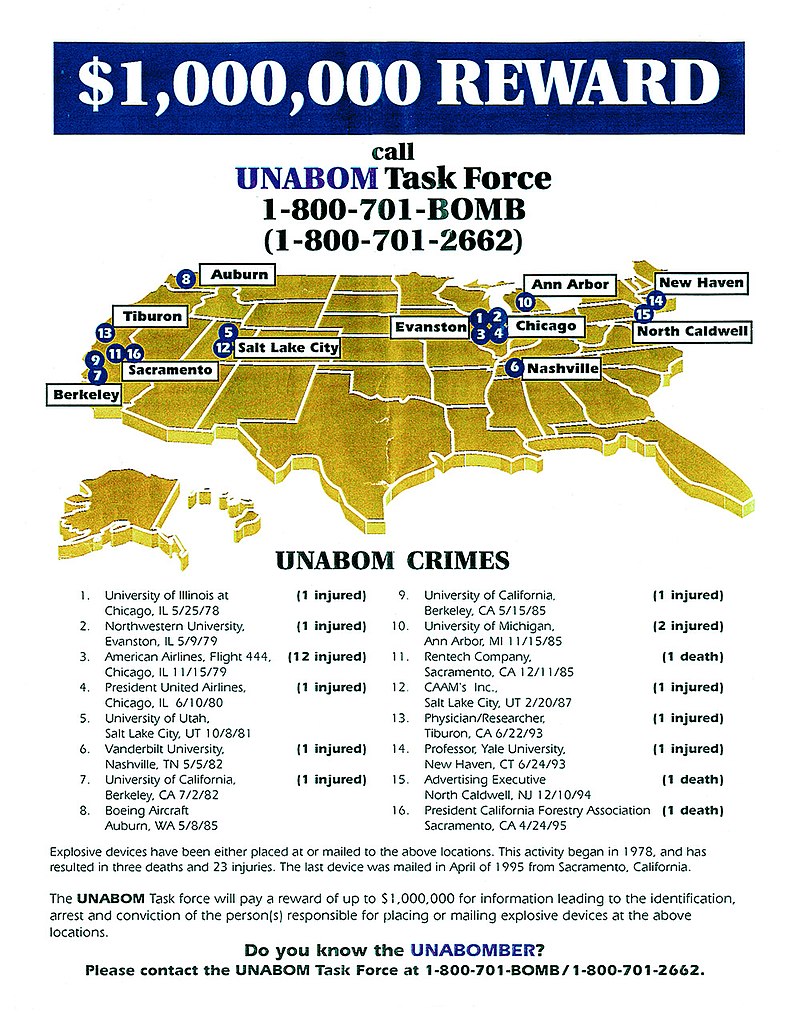
Bombings
Between 1978 and 1995, Kaczynski mailed or hand-delivered a series of increasingly sophisticated bombs that cumulatively killed three people and injured 23 others. Sixteen bombs were attributed to Kaczynski. While the bombing devices varied widely through the years, many contained the initials "FC", which Kaczynski later said stood for "Freedom Club", inscribed on parts inside. He purposely left misleading clues in the devices and took extreme care in preparing them to avoid leaving fingerprints; fingerprints found on some of the devices did not match those found on letters attributed to Kaczynski.
BOMBINGS: TED KACZNSKI May 25, 1978 Northwestern University Police Officer Minor cuts and burns May 9, 1979 Northwestern University Graduate Student Minor cuts and burns November 15, 1979 American Airlines Flight 444 Twelve Passengers smoke inhalation non-lethal June 10, 1980 Percy Wood, President of United Airlines Severe cuts and burns over most of body and face October 8, 1981 University of Utah Bomb defused May 5, 1982 Vanderbilt University Secretary Severe burns to hands; shrapnel wounds to body July 2, 1982 UC Berkeley Engineering Professor Severe burns and shrapnel wounds to hand and face May 15, 1985 UC Berkeley Graduate Student Loss of four fingers and severed artery in right arm; partial loss of vision in left eye June 13, 1985 The Boeing Company in Auburn, Washington Bomb defused November 15, 1985 University of Michigan Psychology Professor Temporary hearing loss November 15, 1985 University of Michigan Research Assistant Burns and shrapnel wounds December 11, 1985 Sacramento Computer Store Owner Death February 20, 1987 Salt Lake City Computer Store Owner Severe nerve damage to left arm June 22, 1993 Geneticist in Tiburon, CA Severe damage to both eardrums with partial hearing loss, loss of three fingers June 24, 1993 Yale University Computer science professor Severe burns and shrapnel wounds, damage to right eye, loss of use of right hand December 10, 1994 New Jersey Advertising Executive at Burson-Marsteller Death April 24, 1995 Sacramento Timber Industry Lobbyist Death WIKIPEDIA
